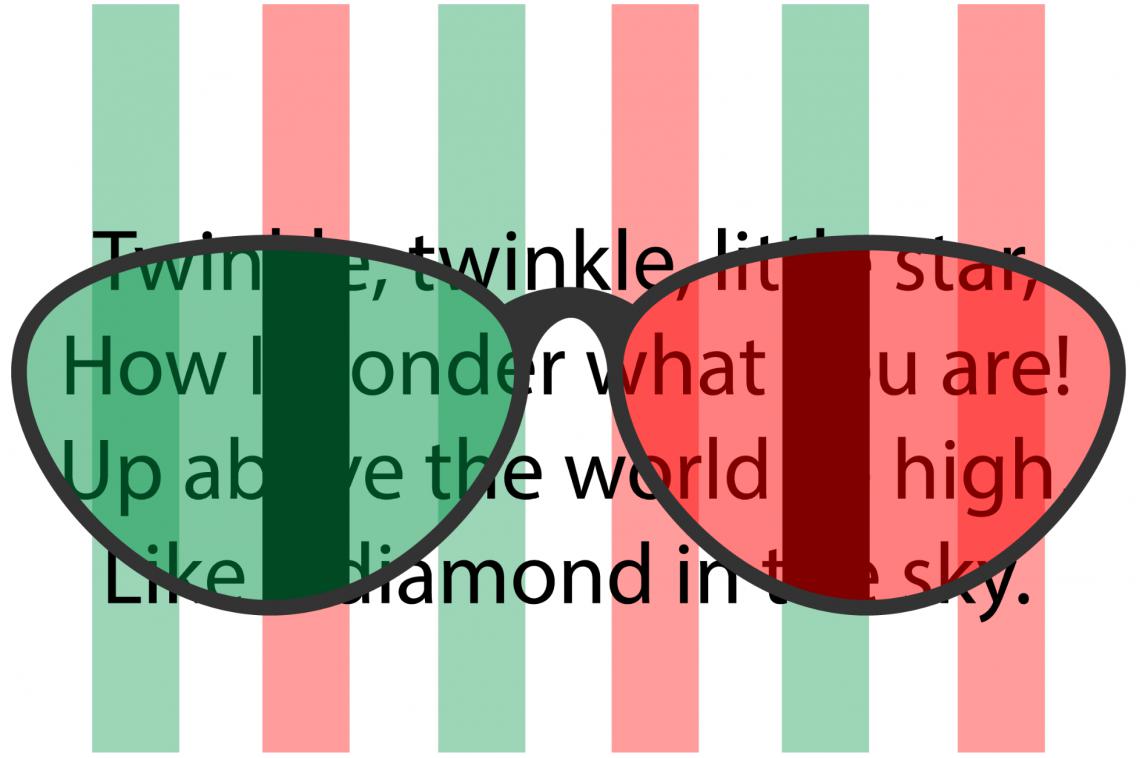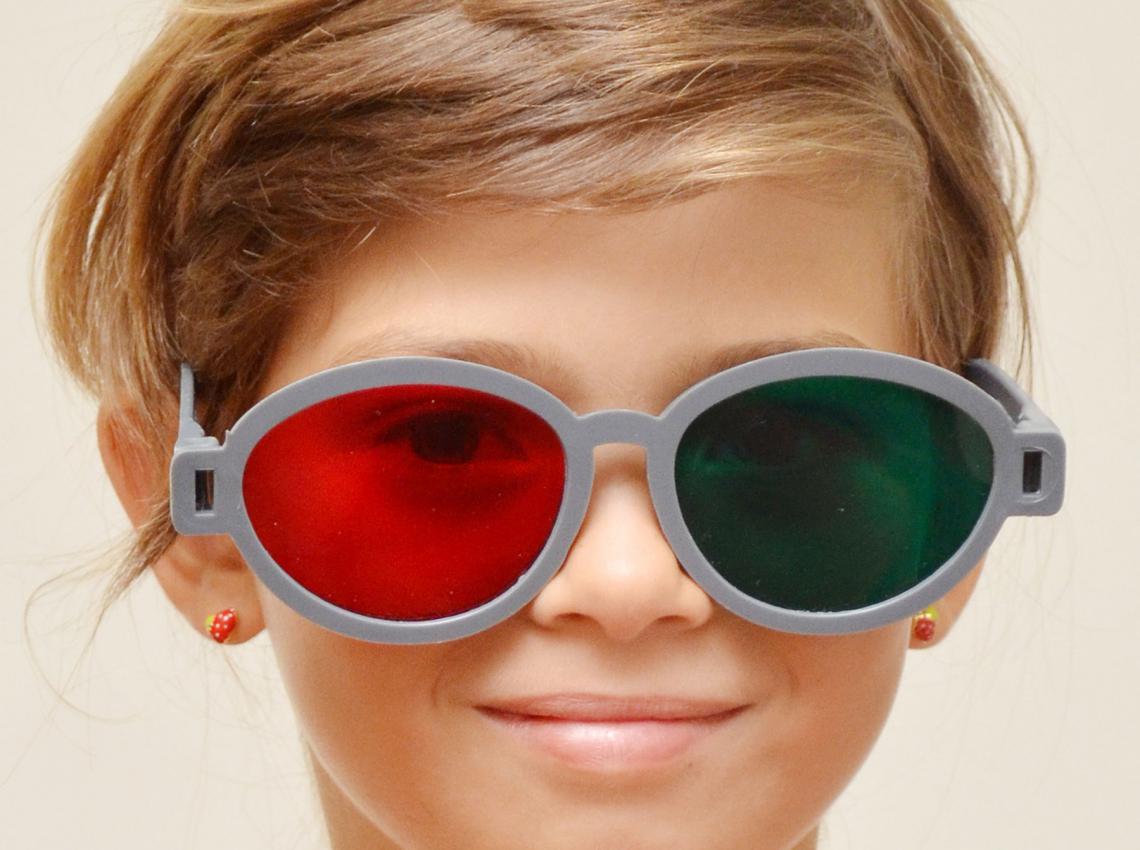What are Red/Green Glasses and Activities?
Red/green glasses are a common tool in the vision therapy room. As the name suggests, red/green glasses are a pair of glasses in which one of the lenses is red and the other green. They are used during anti-suppression activities for patients with amblyopia or strabismus and help teach a patient to use both eyes together, and also to become aware if they are NOT using both eyes together. Vision therapy activities that use red/green glasses use items such as red/green playing cards, red/green reading charts, or red/green items. Take a look below to see how it works.
How to Red/Green Glasses Work?
The common use of red/green activities has the patient wear the red/green glasses with the red lens placed over the right eye and a green lens over the left. This can definitely be reversed, but for our example, we'll keep the red lens over the right eye. Red/green glasses activities are part of a group of activities known as "monocular fixation in a binocular field" (often shortened to MFBF).
During the activity, the patient is then shown a set of images or perhaps a block of text with a see-through red/green film placed over it while wearing the glasses. The end result is the right eye (viewing through the red lens) is unable to see items covered by the green film and the left eye (viewing through the green lens) is unable to see items covered by the red film. Together, a normal patient would be able to combine the images of the right and left eye to overcome the blocked out letters.

An example of what the right and left eye would see during a red/green activity. The red/green lines form the "monocular fixation" components and the clear bars form the "binocular field" components.
Red/green MFBF activities require both eyes work together to react to the target or read text with the red/green overlay. As you can see in the example above, it would be very hard to read the words if using only one eye!

A patient shows how red/green glasses are worn for vision therapy activities.
An important concept of MFBF activities is patient feedback. What this means is that the optometrist or therapist keeps a patient engaged in the activity and makes sure that the patient is not suppressing an eye. This is easily done by asking the patient to say if cannot see certain items or if a colored image has gone missing. This would mean that the patient's visual system is ignoring or suppressing the weak eye. This is common in patients with amblyopia.
Can I use any Red/Green Glasses for Vision Therapy?
Remember, the eye behind the red lens only sees the red targets or words, while the eye behind the green lens only sees the green targets or words. The patient uses the glasses and looks at a picture with red and green targets or words and must work to use both eyes together as a team. There is a requirement that the red/green filters used on the lenses of the red/green glasses match the red and green colors used for the therapy activity. If the filters do not cancel (in the example above, this is shown as the dark line in each eye), a patient could "cheat" at the activity and only use one eye. This would make the anti-suppression activity of little value, so your optometrist or vision therapist is careful to make sure that your red/green glasses and red/green activities work as intended!
Does this Mean ONLY Red/Green Glasses Work for Anti-Suppression Therapy?
Nope. Using the appropriate combination of filters, MFBF activities can be created using this same filtering or canceling concept. For example, some MFBF software activities use red/blue glasses. The idea is the same, the eye wearing the red lens would see any red items and the eye wearing the blue lens would see the blue items. Reds and greens and blues are often used because these colors are robust, but the concept would be similar if you used a pair of orange and purple glasses with orange and purple targets! Many MFBF activities also use polarized glasses. The concept is similar, but now the activity would use a set of polarized bars or polarized objects.
Are Red/Green Activities the only way to do Anti-Suppression Therapy?
Not at all. Although red/green (and other filtered glasses) activities are popular, there are newer methods of anti-suppression activities that go above and beyond what MFBF activities with red/green glasses can offer. Dichoptic training takes MFBF a step further, using a combination of split images along with additional filters, such as a dark or a blur filter, in an attempt to re-balance the input between the right and left eye. The dark and/or blur filters are then adjusted over time as a patient's visual system begins to consistently use both eyes together. Virtual reality offers a unique way to gamify dichoptic training (and other types of binocular training).
The Vision Wiki
- Lazy Eye Treatments
- Optometric Vision Therapy
- Eye Exercises
- Pencil Pushups
- Brock String
- Vision Therapy
- Sports Vision
- Virtual Reality
- Red Green Glasses
- Vision Therapy for Adults
- Vision Therapy Apps
- Vectograms
- Eye Drops for Amblyopia
- Strabismus Surgery
- Eye Patching
- Prism Glasses
- Dichoptic Training
- Binasal Occlusion
- Eye Problems
- Binocular Vision
- Physiology of Vision
- Lazy Eye
- Reading
- Fields of Study
- Research
- Glaucoma
- Virtual Reality
- Organizations
